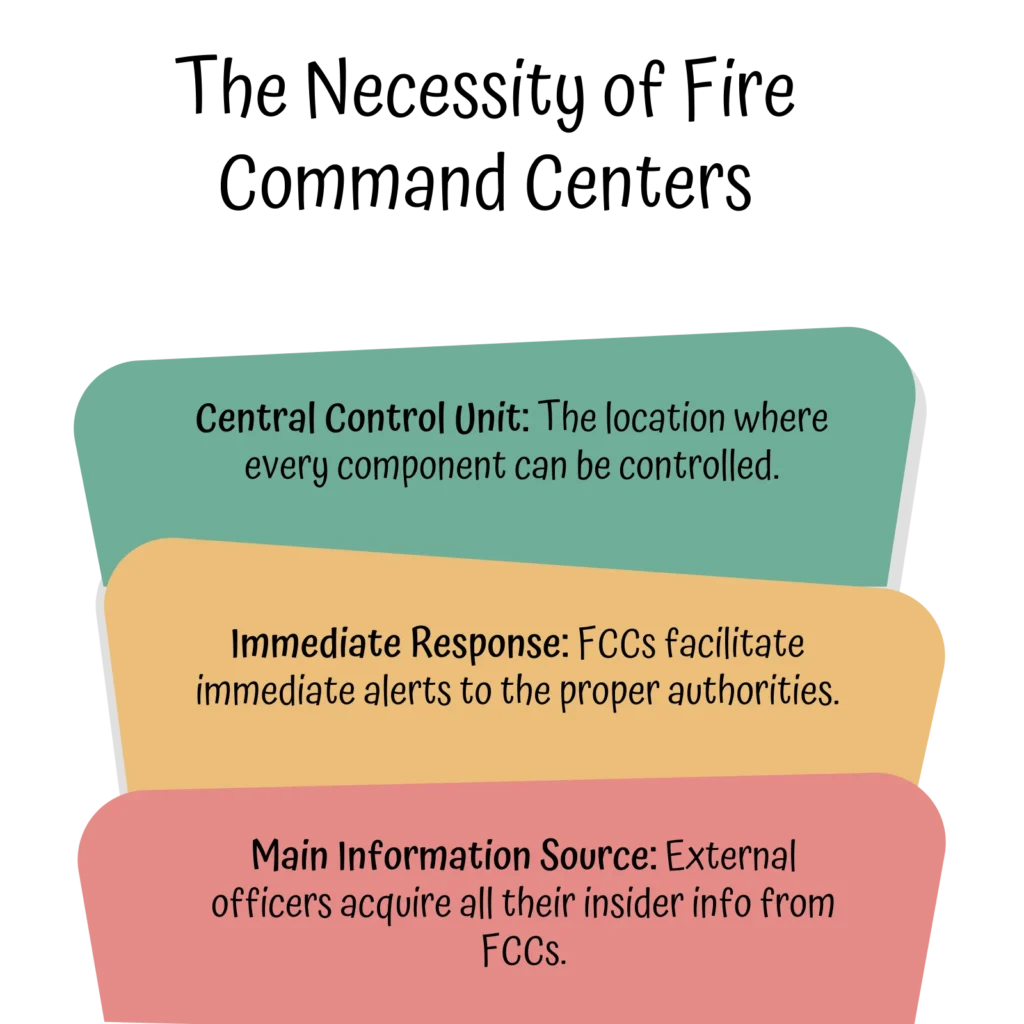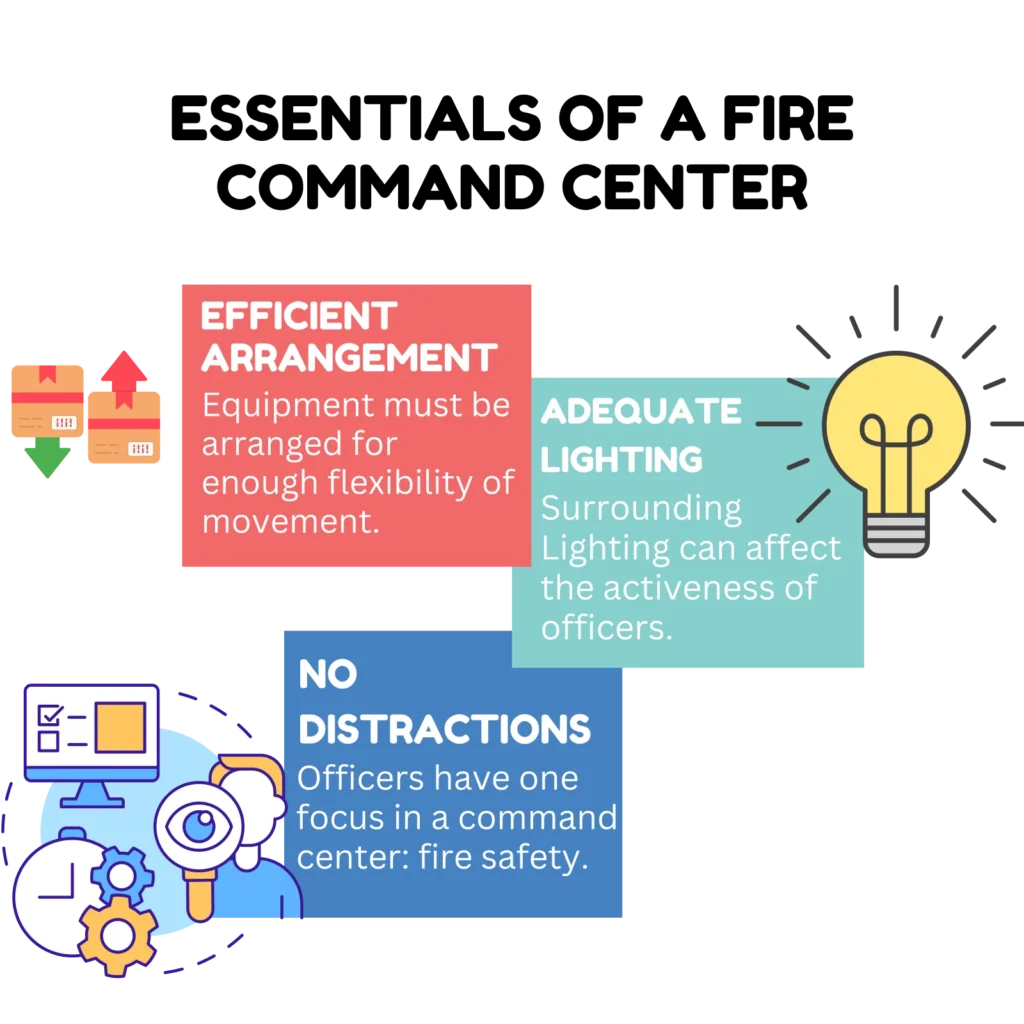Optimizing Fire Command Centers: Communication, Ergonomics, Inspections, and Supplies
The fire command center, a crucial component of a building’s emergency architecture, is the central communication hub when a fire emergency strikes. It is intricately connected to every building’s fire emergency system element.
Fire Command Centers: The Need
Fire command centers are responsible for communicating, coordinating, and controlling every single component in a fire protection system. It is responsible for informing the people in any building when an emergency occurs and then activating the necessary components for a smooth evacuation away from the fire hazard.
Here are the key features of a fire command center,
- Coordinated Efforts: Governmental organizations and agencies involved in fire safety are immediately informed of a fire emergency through an alert from a fire command center. Medical authorities, law enforcement, and firefighters can all be communicated at once and have a constant flow of information about the emergency from the fire command center.
- Spreading Info: External Americans who need information on an emergency, like the public media or associated citizens, get constant updates about a hazard through the building’s fire command center.
- Available Resources: Fire command centers control the usage and quantity of resources in case of an emergency and make decisions about how to use these resources effectively for safety and efficiency.
- Real-Time Support: Command centers can provide the required support that people and the affected buildings need with real-time information and the best measures to implement in such a dire situation.
- Latest Technology: Command centers have the power to develop themselves with the newest available technology, which they can use to respond quickly to a fire emergency and alert the required authorities within seconds of an alert.
- Centralized Communication: Command centers allow communication with all significant authorities during an emergency. They can also be an interlinking connection between these agencies, providing a single source of information and data transfer.

What Should A Command Center Have?
After considering the need for a fire command center, it is self-explanatory that it is essential to life safety during a fire emergency and must be equipped with the right components to achieve the best results. Similar to codes and regulations, the requirements for these centers are also updated from time to time.
Inspections must occur monthly if a fire official hasn’t continuously monitored the fire command center. Regular inspections of the components and the connection are mandated for proper life safety and to ensure that systems work when needed in a fire emergency.
Here are some official requirements of the International Fire Code for a fire command center that need to be verified and checked for during inspections for approval,
- The command center must be in a zone that is at least a one-hour fire barrier away from the rest of the building structure it is built in.
- The center must have a building information card detailing the structure and architecture and also a sanctioned worktable.
- Complete building plans with schematics indicating all the info needed about the emergency routes, fire exits, fire protection devices, location of fire devices, control panels, and anything else related to the fire protection plans.
- The center must have access to the public telephone network of the fire department through a direct connection.
- It must contain the fire department’s communications system.
- A separate control panel that can control the air distribution systems like vents for controlling smoke or exhaust.
- Devices with 24/7 supervision on the main generators of the system and control switches for the same.
- The size of the command center room needs to be a minimum measurement of 8’ by 12’. This room and its arrangement need to be verified by an official fire code official before approval for usage.
- A command center control unit needs status displays and control switches for fire sprinkler systems, water flow detector systems, fire pump status, and emergency power levels.
- The whole alarm system must be a voice-informing evacuation system that can address the people in the building who need to evacuate immediately.
- All the fire alarms in the system must have a control unit and a master microphone setup.
- The command center must be in a zone that is at least a one-hour fire barrier away from the rest of the building structure it is built in.

Fire Command Center Ergonomics
Ergonomics can be defined as ensuring that a work environment is safe and constructed to be the most productive setting for a worker. It focuses on making an area much safer and easier to work in, thus increasing safety levels and leading to more efficient work output.
The ergonomics of a fire command center are essential because of its increased importance in a fire emergency. A command center is necessary to avoid significant problems from a fire accident, or the whole scene could become problematic.
So, the ergonomics of a command center needs to be a certain way so that proper communication can flow during the emergency properly and effectively. Here are a few specifically essential factors to consider when making an ergonomic command center,
Ergonomic Chairs
Specialized chairs are needed for the environment of a command center. Still, cheap regular chairs cannot provide the stability officers need to be alert and comfortable simultaneously.
- These chairs will be used by officials 24/7, so the material and padding of the chairs have to be up to the mark so that they are medically proper and comfortable.
- Customizable and adjustable options are needed for the chairs to fit the requirements of any person’s body type.
- Proper support for the back is essential in keeping officers alert in situations that need their full attention.
- The pressure of command centers can sometimes get overwhelming; hence, a sense of comfort from chairs can help destress difficult moments.
Surround Lighting
Lighting can have a pretty profound effect on the attentiveness and energy of officials in a command center.
- It can directly influence the performance and health of officers within the room.
- Adjustable light levels should be provided to avoid glare on the computer and display screens within the room.
- The provision of windows is essential for access to natural light sources, which can reduce fatigue and improve a person’s overall state of mind.
- LED task lighting can be the best light source without natural light and should also be adjustable.
Sit Stand Tables/Workbenches
Workbenches are the access point for officials to act in an emergency. Hence, they must be arranged in the best possible way to be comfortable and understandable, as a command center can also be confusing with so many components.
- The tables should be height adjustable so officers can continue operations whether sitting down or standing up.
- Adjustable tables can also be configured personally according to every person’s body type and preferences.
- Changing positions between sitting and standing can also benefit officers, keeping them more active and alert.
Clean Table Space
A cluttered and unorganized space can be very confusing, especially in the fire command center environment, which has multiple components in a single setting.
- Control rooms generally need a large surface area to prevent the need to push multiple interfaces into one unorganized setting.
- The same goes for accessing all the required components from one position. Multiple pieces or components need to be arranged in the correct structure so that there is not too much and everything is accessible.
- Cluttered views can also be distracting, causing officers to lose focus on what they should be focusing on at the time.
- Proper cable management is another point here that can influence a system’s arrangement and clean integrity.
Look at another one of our blogs here for a more in-depth look at how fire alarm systems should be maintained and replaced at the right time. Also, to make things easier for your fire protection system inspections, we’ve created a comprehensive library of 500+ checklists that you can instantly download and use for free!
Once completed, the inspection report can be exported in a file of your choice (PDF, Word, Excel, Weblink). See the sample image below of what an exported fire inspection report looks like:
Explore more templates
Welcome to the Ultimate Heat Detector Placement Template! Designed with a decade of industry insight, our template offers precision in fire safety planning.
Welcome to our Fire Command Center Ergonomics template – your key to optimizing emergency response efficiency.
“Optimize safety with our Fire Command Center Inspection template – a comprehensive tool designed for ensuring the readiness and functionality of your command center.
Fire Command Center Supplies encompass the essential equipment and materials necessary for managing fire safety and emergency response operations within a command center or control room.
Tailored to meet your specific requirements, enabling you to manage
inspections and reports with greater detail and efficiency
ZenFire is a lot more customized to my business. Before I was using a generic app, I could not customize, like I do now."
